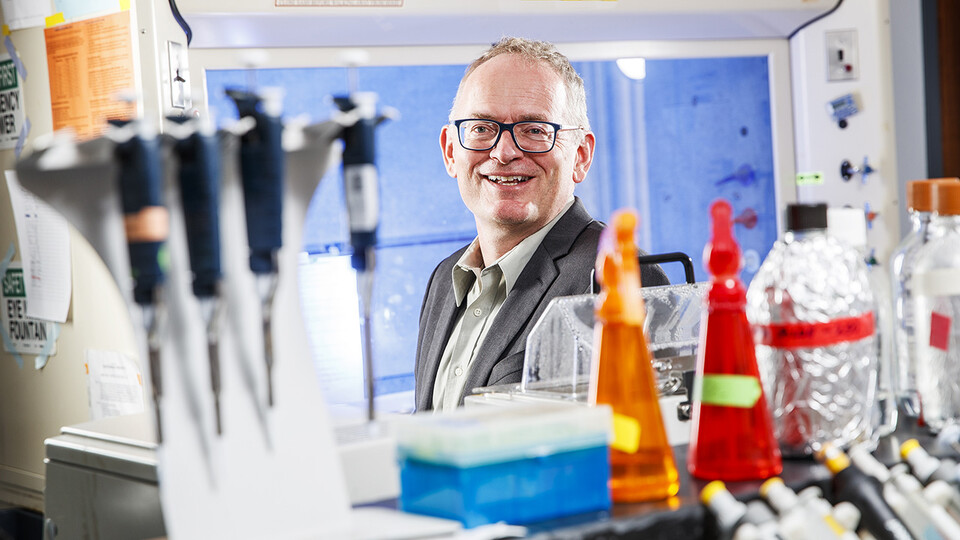
Nebraska-led project examines milk as possible cancer fighter
11 May 2022 By Geitner Simmons - IANR Media
In health care, perhaps no word sends a more chilling message than “cancer.” Brain tumors, for example, prove especially resistant to current treatments. Only 5% of patients with that condition survive more than three years and the median survival time is 10 to 14 months.
But an innovative research project by University of Nebraska–Lincoln scientists offers the potential for a breakthrough. In a federally funded project, Janos Zempleni, a professor with the Department of Nutrition and Health Sciences, and Husker colleagues are pursuing a surprising way to use milk as the vehicle delivering cancer-fighting therapeutics to the brain.
The concept isn’t as fanciful as it might sound — it’s building on recent science. Preliminary findings in recent years show that it’s possible to manipulate the body’s genetic function to reduce the growth of tissues, including cancerous tumors. Scientists achieve that result by directing a type of gene regulator known as siRNAs to the targeted tissue. Genetic signaling carried by the siRNAs shuts down genetic function that enables new tissue growth.
But converting that preliminary finding into effective medical treatment has run into obstacles. So far, scientists have not been able to find an efficient way to deliver the genes consistently to the targeted area and in sufficient quantity.
Milk, it turns out, offers a good chance to solve the problem. Humans absorb siRNAs through food, recent research shows. And milk, Zempleni has found, stands out for its robust ability, once ingested, to help the genes accumulate naturally in the brain.
In their project, the Husker researchers will hone milk-focused techniques for effective gene delivery. Specifically, the project will use milk-transported siRNA genes to shut down the growth function of a gene known as IDH1, whose mutations result in brain tumors. The research also offers hope in addressing rare brain-centered genetic abnormalities affecting young children, said Zempleni, Willa Cather Professor of molecular nutrition and director of the Nebraska Center for the Prevention of Obesity Diseases.
The U.S. Department of Agriculture has provided a $630,000 grant to support the project. Zempleni will lead the research, in collaboration with Forrest Kievit, assistant professor of biological systems engineering, and Jiantao Guo, associate professor of chemistry. USDA’s National Institute of Food and Agriculture awarded the grant.
The long-term potential of this science is “enormous. It has not been realized yet at all,” said Zempleni, a fellow of the American Association for the Advancement of Sciences and winner of the Institute of Agricultural and Natural Resources’ 2015 Omtvedt Innovation Award.
Zempleni and his colleagues will use genetic science and chemistry to load exosomes, a natural nanoparticle in milk, with therapeutic material including siRNAs. Loading the material on cow’s milk exosomes would first require genetically modifying the cow, an enormously tricky task. So, the researchers instead will culture MAC-T cells (similar in genetic composition to cow’s milk cells) in the laboratory to produce exosomes, then direct them to brain tumors in mice.
The researchers aim to develop techniques that achieve two goals: Have the siRNAs effectively and consistently reach the tumors and have the siRNAs accumulate in sufficient quantity to reduce the tumor growth.
If this technology proves viable, large-scale production of exosomes will be needed to meet real-world patient demand. Laboratory cultures can supply only a small volume of exosomes. A cow, in contrast, can provide an ample number through its milk.
So, the Husker researchers aim, long term, to take a big step if their current research reaches its gene-delivery goals: They will seek to develop a genetically modified cow.
Such a cow, Zempleni wrote, would secrete “milk exosomes conducive to maximal delivery of RNA therapeutics to brain tumors in human cancer patients.”
The pharmaceutical industry is already using this general concept. It’s known as biopharming, meaning the use of animals in producing medical treatments. The drug Atryn, used to prevent blood clots in patients with a rare disease, is derived from the milk of genetically engineered goats.
“With our technology, you could actually use these milk exosomes, attach the appropriate feature and deliver a therapeutic to folks suffering from these rare diseases,” Zempleni said. “I think this could be a huge game changer if we get a funding agency to take the risk of developing these animals. That is a difficult task. With the MAC-T cells, it’s relatively easy, but taking this to livestock, a goat or a cow, it’s way, way complicated.”
Husker research has been pioneering in identifying the importance of milk as a potential gene delivery mechanism. In 2014, Scott Baier — a doctoral candidate in Zempleni’s lab — proposed an initial research project on the subject, culminating in a Journal of Nutrition paper that he, Zempleni and other Husker colleagues co-authored. The article since has been cited academically almost 300 times. Baier received his doctoral degree in nutrition science from Nebraska in 2015 and now is senior director of medical strategy at Vaniam Group, a company focusing on transformative cancer therapies in Dallas.
Zempleni’s path to the scientific exploration of genetics and food science began in his teenage years in his home country of Germany.
“I loved biology but at that age, I loved to go fishing — I was very much into all these native species of fish from Germany,” he said.
In succeeding years, his interests broadened, gradually shifting “from fish to biology to science.”
“I was torn between biochemistry or nutrition science,” he said. “I think in hindsight I made the right choice going with nutrition science. It’s a very comprehensive approach, and it allowed me to delve deeply into biochemistry and molecular biology. So, I think I’ve got the best of both worlds.”
College of Education and Human Sciences
Nutrition and Health Sciences